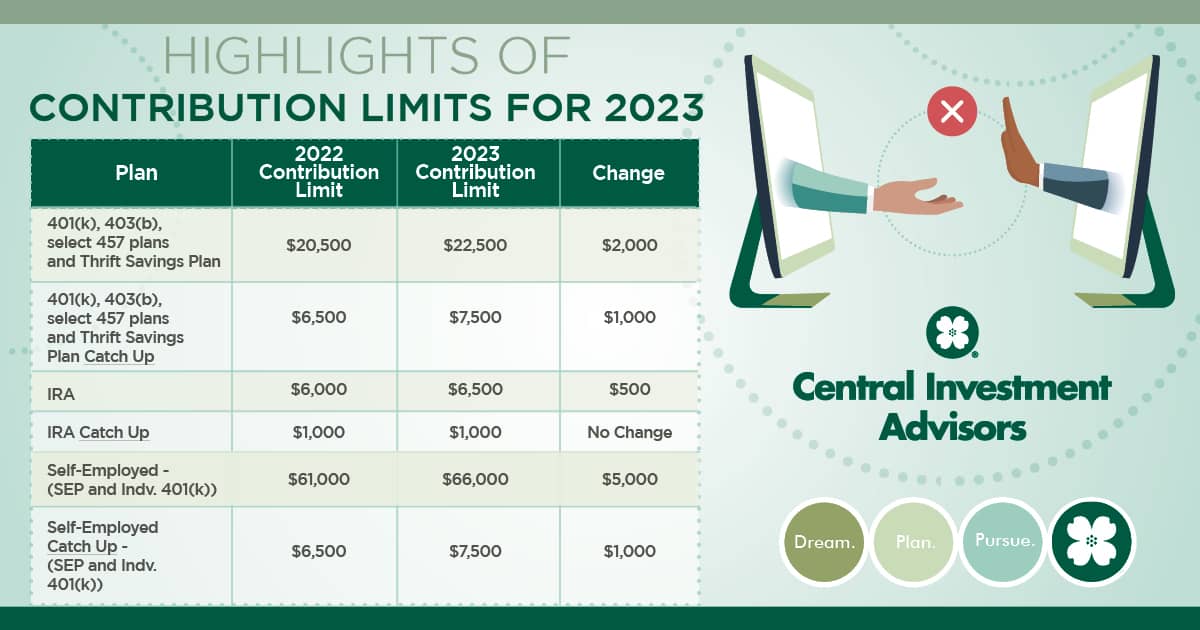
Central Investment Advisors can help you navigate changes in the economy and tax laws which could affect retirement planning.
Watching the prices of virtually all consumer goods climb steadily for more than a year has many people tightening their grip on their wallets. The highest inflation in 40 years results in financial stress and difficult decisions about where to spend hard-earned money and how to make ends meet.
However, as we look forward to 2023, there are a few bright spots for individuals who are able and willing to invest in their retirement savings plans. While the prices of milk and gas have been on the rise, the Internal Revenue Service has also needed to adjust retirement plan limits for inflation.
Which changes will get you the most bang for your inflation-era dollars and which ones are getting the biggest changes to their limits? First and foremost, it is smart to make a contribution (no matter how small) to a retirement account; and consolidating your accounts is also in your best interest. Our calculator can help you learn about saving for retirement.
What are the options?
401(k)
A retirement savings and investing plan offered by your employer. Funds are automatically withdrawn from an employee’s paycheck before taxes and invested in funds offered by your employer.
Contributions limits for these accounts are increased by nearly 10 percent for 2023, from $20,500 to $22,500.
The limits are the same for 403(b) accounts offered to employees of tax-exempt non-profit organizations and 457(b) accounts offered to government employees.
Simple IRA (SIP)
Usually used by small businesses with 100 or fewer employees. These accounts are less complicated to set up than 401(k), but work in the same fashion with both the employee and the employer making contributions before taxes.
IRA
An individual can make contributions on their own which may be eligible for a tax deduction when they are filing their income tax return. Earnings can potentially grow tax-deferred until withdrawn at retirement (age 59 ½) when earnings will be taxed. The annual contribution limits have jumped from $6,000 to $6,500.
Roth IRA
An individual makes contributions after taxes, and money grows tax free, with tax-free withdrawals at retirement (59 ½) Roth IRA can also be withdrawn for a qualified first-time home purchase.
Just like the simple IRA, the contribution limits for a Roth IRA have increased from $6,000 to $6,500.

What else has changed?
However, there are income thresholds tied to the tax advantages on both IRAs and Roth IRAs – depending on your income and your opportunity to contribute to a retirement plan at your place of employment – you may or may not qualify.
Even if you can’t contribute the maximum amount to your retirement plan, any contribution you can make is important. If you fall into the low- or middle-income category there are still big benefits to making contributions to retirement accounts. The saver’s credit is a tax credit of up to $1,000 filing individually and up to $2,000 filing jointly who put money in their retirement account – but your annual adjusted gross income must fall at a certain threshold, all of which have been increased for 2023 -- $54,750 if filing as head of household, $73,000 if filing jointly. Get all the details on the 2023 saver’s credit from the IRS.
If you are part of the over 50 population, you can make additional contributions, referred to as catch-up contributions (over and above the standard amount) to your retirement accounts to boost your retirement savings. The limits on those have not been adjusted for inflation and remain at an additional $1,000 on an employer-sponsored retirement plan and $500 for a simple IRA.
As always, there are many variables in tax laws. Your financial advisor can assist with providing information relevant to you and your retirement planning.
Neither LPL Financial, nor its registered representatives, offer tax or legal advice. Federal tax laws are complex and subject to change. As with all matters of a tax or legal nature, you should consult with your own tax or legal counsel for advice.
Contributions to a traditional IRA may be tax deductible in the contribution year, with current income tax due at withdrawal. Withdrawals prior to age 59 ½ may result in a 10% IRS penalty tax in addition to current income tax. A Roth IRA offers tax deferral on any earnings in the account. Qualified withdrawals of earnings from the account are tax-free. Withdrawals of earnings prior to age 59 ½ or prior to the account being opened for 5 years, whichever is later, may result in a 10% IRS penalty tax. Limitation and restrictions may apply.
Category: Markets & Economy
